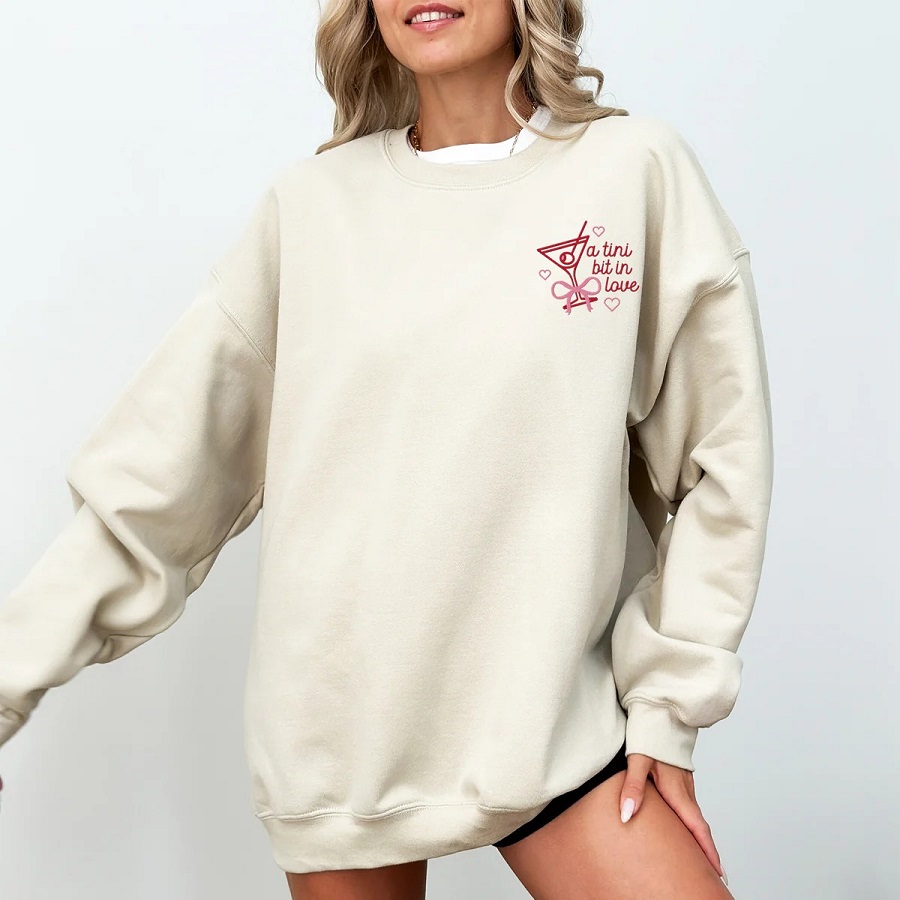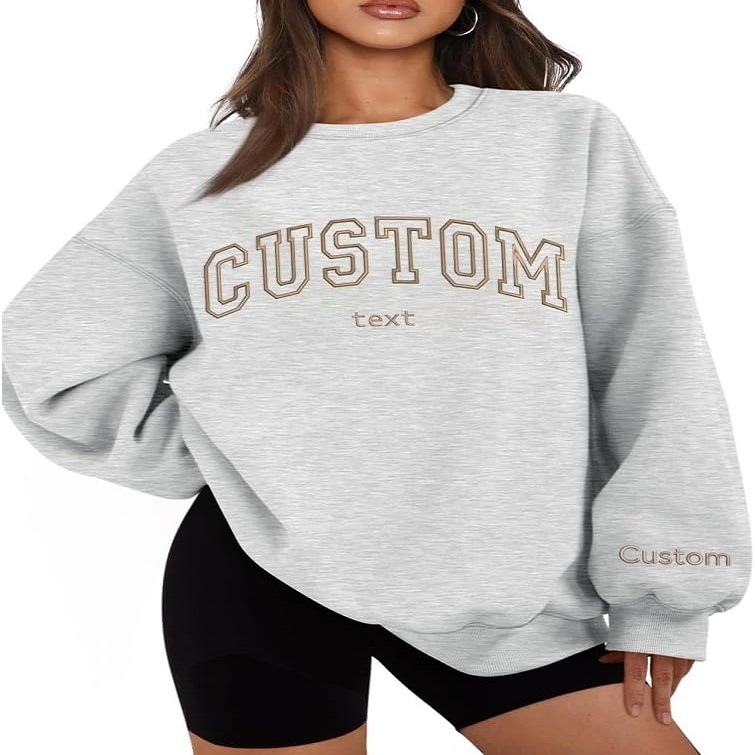The Evolution of Embroidery in Fashion
Embroidered sweatshirt has a rich history in the world of fashion. From intricate handmade designs to high-speed machine creations, the embroidered sweatshirt has evolved significantly. It began as an art, with each stitch carefully crafted by skilled artisans. Royalty and the elite often wore embroidered garments as status symbols. Over time, embroidery became more widespread. As technology advanced, so did techniques. Machine embroidery emerged, changing the fashion landscape.

Hand-Stitched Embroidery: A Tradition of Craftsmanship
Hand-stitched embroidery is an age-old art form prized for its craftsmanship. Unlike machine embroidery, every stitch is the result of careful, meticulous work by an artisan. This process involves dedication, skill, and an attention to detail that is less common in mass-produced items. Embroidered sweatshirts that boast hand-stitched elements carry a piece of history and tradition. Each piece is unique, reflecting the style and spirit of the individual who made it.
The beauty of hand-stitching lies in its imperfections. These slight variations add character and uniqueness to each embroidered sweatshirt. Hand-stitching allows for an expansive range of techniques, from simple backstitches to complex patterns. This flexibility is a hallmark of handcrafted embroidery, enabling designers to create intricate, bespoke designs that stand out.
Machine Embroidery: Advancements and Efficiency
Machine embroidery marks a significant turn in fashion history. It brought mass production into reality. Unlike the slow, intensive process of hand-stitching, machines work at a rapid pace. This change meant manufacturers could produce more embroidered sweatshirts in less time. Machine embroidery is efficient and precise. It ensures uniformity across products, which is crucial for brands. Consistent quality is a big benefit in retail. Designs made by machines are repeatable, with no variation.
Advancements in technology have made machine embroidery more versatile. Modern machines handle complex designs with ease. They offer a range of stitch patterns and thread colors. This capability bridges the gap between handmade charm and industrial efficiency. Multicolor designs are easy to reproduce, keeping the cost low. They also maintain high standards of quality for embroidered sweatshirts.
Furthermore, machine embroidery uses software to control the stitching. This allows for quick adjustments and customization. The digital nature saves time during the design phase. Once programmed, the machine can replicate the design countless times without errors. This repeatability is what places machine embroidery at the forefront of high-volume fashion.

Comparing Quality and Aesthetic Appeal
When discussing embroidered sweatshirts, quality and aesthetic appeal are crucial. The debate between hand-stitching and machine embroidery is ongoing. Both methods offer different benefits that affect the look and feel of the final product.
Hand-Stitched Embroidery: Unique Charm
Hand-stitched pieces stand out for their unique charm. They boast subtle imperfections, which add a sense of authenticity. Each embroidered sweatshirt has its own story, evident in the one-of-a-kind details. The quality is high, with careful attention to every stitch. This creates not just clothing, but wearable art.
Machine Embroidery: Consistent Precision
On the other side, machine embroidery offers consistent precision. Every product is the same, which can be important for brands. The stitches are even, creating a sleek and professional look. While less unique, the quality is reliably high. Machines produce clear, crisp designs on every embroidered sweatshirt.
Aesthetics: Personal Preference
Aesthetics is a matter of personal preference. Some prefer the bespoke feel of hand-stitched items. Others choose the modern, clean lines that machines produce. What’s clear is that both methods can make an embroidered sweatshirt beautiful. The choice depends on the desired look and the value placed on craftsmanship versus uniformity.
Cost Analysis: Hand-Stitching vs Machine Embroidery
When considering the cost of an embroidered sweatshirt, one must differentiate between hand-stitching and machine embroidery. Here’s a detailed breakdown:
Hand-Stitching: Labor-Intensive Equals Higher Costs
Hand-stitching is labor-intensive. Each piece requires hours of an artisan’s time, which increases the cost. Artisans must be compensated for their skill, making hand-stitched items generally more expensive. Due to this, hand-stitched embroidered sweatshirts often have a higher price tag.
Machine Embroidery: Efficiency Reduces Costs
Machine embroidery is much more cost-efficient. The initial investment in machinery is high, but production costs decrease over time. Machines produce large quantities quickly, so the cost per embroidered sweatshirt becomes lower. This lower cost makes machine-embroidered items more accessible in the market.

Production Time: Evaluating Speed for Business Needs
When weighing options for embroidered sweatshirt production, time is a key factor. In the fashion industry, speed can determine market success. Here’s how production time breaks down between hand-stitching and machine embroidery.
Hand-Stitching: Slow and Steady
Hand-stitching takes time. Each embroidered sweatshirt is a work of time-consuming craft. Artisans pour hours into creating unique designs. The slow pace means less output. For businesses, this might limit stock and delay delivery. It’s ideal for custom, limited-edition runs.
Machine Embroidery: Fast and Consistent
Machine embroidery speeds up production. With machines, multiple sweatshirts get embroidered at once. It’s much quicker than hand-stitching. Businesses can meet high demand and refill stock swiftly. Machine embroidery allows for keeping up with trends quickly.
Production time can be the deciding factor for many businesses. While hand-stitching boasts quality, machine embroidery wins in speed. This efficiency is crucial for staying competitive in a fast-paced marketplace. It’s not just about speed, but also about meeting consumer expectations and managing inventory effectively.
Customization and Personalization Options
Customization and personalization are key in today’s fashion world. They allow customers to express themselves through unique designs on their embroidered sweatshirts. Here are the differences between hand-stitching and machine embroidery when it comes to personalizing your garment.
Hand-Stitched Embroidery: Tailored to the Individual
Hand-stitching stands out for custom work. With it, artisans can tailor every detail to a person’s taste. They can make small changes or create a whole new design. This means each embroidered sweatshirt can be one-of-a-kind. The process is ideal for those who value individual expression and want a piece that’s truly theirs.
Machine Embroidery: Mass Customization
Machine embroidery offers a different kind of personalization. It uses software to add names, initials, or unique patterns. While not as tailored as hand-stitching, it’s great for large orders. Teams or companies can get their logo on a sweatshirt with ease. The designs are less unique but still give a personal touch. This is a smart choice for making sure a group stands out together.
If you’re after a piece that’s bespoke and unique, hand-stitching is the way. But if you need many sweatshirts fast, with a custom feel, machines are best. Both options offer ways to make an embroidered sweatshirt reflect personal style or group identity.
The Environmental Impact of Embroidery Techniques
The way we produce embroidered sweatshirts affects our planet. Both hand-stitching and machine embroidery have environmental aspects we need to consider.
Hand-Stitching: Sustainable but Limited Scale
Hand-stitching is often seen as more sustainable. It does not require electricity or machinery, reducing its carbon footprint. Artisans use their skills, making fewer pieces over a longer time. This method produces less waste and doesn’t need large factories. However, its scale is limited. It cannot meet large demands without impacting the environment more.
Machine Embroidery: Energy Intensive but Scalable
Machine embroidery consumes more energy. It uses electricity to run machines and can produce waste. But, it’s able to make many embroidered sweatshirts quickly. It’s scalable, meaning it can meet high demands. Some machines are energy-efficient. This helps to reduce their environmental impact. Still, the production process can create pollution.
In either option, material choice matters. Organic or recycled fabrics and threads lower environmental harm. Both methods can be part of a green strategy if managed well. It’s about balancing scale, efficiency, and sustainable practices.

Conclusion: Choosing the Right Method for Your Needs
In the embroidered sweatshirt showdown, both hand-stitching and machine embroidery have their merits. It comes down to balancing your specific needs with your values. If you seek an exclusive, artisan-crafted piece, go for hand-stitched embroidery. Expect to pay more for the skill and time invested in each garment. On the other hand, if you need consistency, speed, and a lower cost per item, choose machine embroidery.
